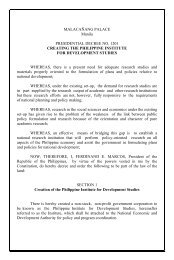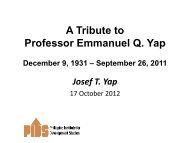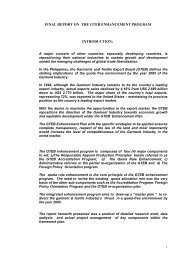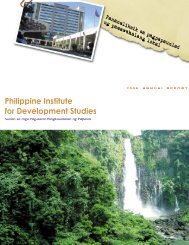being copies comments refinements necessarily
Land Reform and Changes in Land Ownership Concentration ...
Land Reform and Changes in Land Ownership Concentration ...
Create successful ePaper yourself
Turn your PDF publications into a flip-book with our unique Google optimized e-Paper software.
In the study villages a 100 percent accomplishment on land distribution based ontargets have been achieved. However, land distribution has been implemented at aslower rate in the hacienda and irrigated village (NE1) than in the rainfed area (NE2)based on the accomplishment under PD27. While 74% of the land reform area in NE2has already been distributed under PD 27 (EP titles) only 55% have been distributed inNE1. The accomplishment of NE1 under PD 27 is much lower than the average for theprovince.About 30% and 20% of the scope of land reform in NE1 and NE2, respectivelywere completed under CARP. It is also observed that several beneficiaries in NE1 arestill holding collective titles (i.e. CLOA-C). Collective titles are issued in the absence ofsubdivision plans that will identify specific areas of farmer beneficiaries. DAR may notbe able to immediately undertake subdivision surveys due to budgetary constraints (dela Cruz et al. 2003). However, it is also possible that some beneficiaries specificallybeneficiaries who have close family ties have no immediate need to subdivide theproperty.A major difference in PD 27 and CARP is that several modes of land distributionhave been made available under CARP. Land distribution under PD 27 wasimplemented primarily through compulsory acquisition. CARP, however, offered severalmodes of land transfer. One mode is the Voluntary Offer to Sell (VOS) which provides anincentive to landowners who voluntarily surrender their land for land reform. Theincentive is in terms of a 5% increase in the cash portion in the landlord’s compensationcompared to a compulsory acquisition. 13 Another mode is the Voluntary Land Transferor VLT scheme which involves a direct payment arrangement (in kind or cash) betweenthe landowner and beneficiaries based on a contract agreement that is approved by theDAR. In a VLT arrangement, the government has no monetary obligation to thelandowner.The VLT scheme is noted to be popular in the study villages specifically in NE1.In the former hacienda village (NE1) 37.6% of the scope of OLT have been distributedvia VLT (Table 4). In NE2 land distribution via VLT is about 21%. This implies that ofthe total land distributed under CARP, about 84% and 81% of in NE1 and NE2,respectively were accomplishment under the VLT.V. Land Transfer Actions of Agrarian Reform BeneficiariesThe break-up of large estates into small farms through land reform has increasedtransactions in the rural land market. Property rights on land have provided the farmerbeneficiaries access to the land market through the trade of ownership rights andusufruct rights in exchange for money. These land transactions referred to by DAR asland transfer actions of farmer beneficiaries require the farmer-beneficiary to “give up hisright to be in continuous possession and cultivation of the awarded landholding in favorof another person who is willing to cultivate the property”. Often, these actions lead tochange of ownership although some transactions are purely for credit reasons.13 Payment to landlords is in the form of cash and bonds. Cash payment varies depending on land size- forlands 24 hectares and below, 35% cash; between 24 to 50, 30 % cash and from 50 hectares and above,25% cash. The remaining balance is paid in the form of LBP bonds with interest rates based on a 90-dayTreasury bill rates. One-tenth of the face value of the bonds matures every year until the 10 th year (RA6657;sec 18).9









